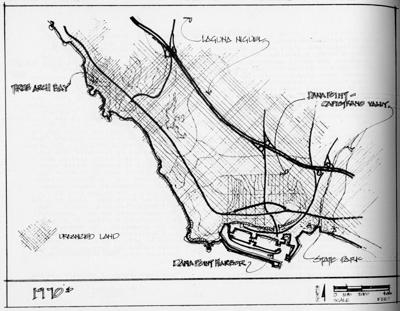
Coast Freeway 1970: Proposed freeway in 1970 from South Coast Scenic Improvement Plan (1969) which included the current revitalization of the Dana Point business district. Courtesy Orange County Archives.
By Carlos N. Olvera
This column has always focused on what was, but now is gone. As my mentor, Doris Walker said and imparted on me, “If things do not change, what would I write about?” Change in Dana Point has always been long in coming. And when it does, it is met with resistance, and sometimes it is stopped. A case in point is the “Pacific Coast Freeway.”
In 1956, President Eisenhower signed the Federal-Aid Highway Act. It was then boasted as a $1.1 billion fund and called “the greatest public-works program in the history of the world.” And every state wanted a piece of that pie. Orange County was no different.
In June 1957, members of the California State Highway Commission studied a proposal for the construction of the Orange Coast Freeway, an inland route to replace Pacific Coast Highway. It was to connect Long Beach to the San Diego Freeway, under construction at the time, at Capistrano Beach. It was scheduled to cut through Newport Beach at 16th street and go through Laguna Beach.
But in 1960, Orange County Supervisors wanted to probe that alignment so an agreeable route could be recommended to the state, as by this time the state hadn’t provided an actual road map. But soon word of bisecting Laguna Beach came, which only caused Laguna Beach to mobilize groups opposing the plan. As a result, the state became firm in its plans but chose not to air them resulting in a protest against any plan and not just the location. By October 1964, the county finally said it had to go around Laguna Beach and stay away from the coast. However, in Dana Point, it would cross Del Obispo.
In a 1969 report, the following was said of Dana Point: “Growth has been slow and development uncontrolled, but the two major elements, the Dana Point Harbor and the Coast Freeway, are going to produce more change in the area in the next 10 years than in the last 200.” The now called Pacific Coast Freeway, from Corona Del Mar to Capistrano, became eighth on the priority list of Orange County freeways with a proposed “scenic highway” designation.
In the 1970s, there was a widespread revolt across the U.S., including significant political opposition to freeways. The rising fuel costs due to the oil embargo and long gas lines put a cloud over scenic driving. Laguna Niguel homeowner associations got into the picture, opposing the plan that hadn’t started yet. It was estimated 665 residents would need to move. The freeway would go through Dana Point where Dana Hills High School now sits. While that freeway debate was going on just north of us, the county started planning for the new freeway by making Golden Lantern an off ramp and a six lane highway to the Harbor. The “improvement” included a 40-foot easement removing 10 homes on the east side between PCH and Selva Road that remains today. Despite the objection of residents, the Fifth District Supervisor, Ronald Caspers of Newport Beach, made the motion to approve the acquisition saying it was the least costly option.
Opposition mounted, city by city, along the route to re-study it. Among those joining in opposition was Supervisor Caspers—as the route had now changed to include impacts in Newport Beach—who suggested the study involve a no route option.
As delays continued, financial difficulties, including the lack of federal funds, were raised, delaying construction at least into the 1980s. The state legislature was canceling several portions of the major planned freeways, including nearly 100 miles of the Pacific Coast Freeway. By August 1972, the governor signed three bills deleting the proposed Pacific Coast Freeway.
By April 1973, the county had not dropped the freeway zoning. Even developers were subject to constantly changing conditions. The Thunderbird Development, which the planned freeway would go right through, sought a zone change from open space/residential to high-density and commercial. Then when the developer wanted to go back, the county said no, and that a transportation corridor was still needed. But by 1975, the state had already sold several properties at auction.
Only about 68 percent of the national freeways planned in the ’60s were ever completed.
Carlos N. Olvera is Vice Chair of the OC Historical Commission and a Dana Point City Councilman.


